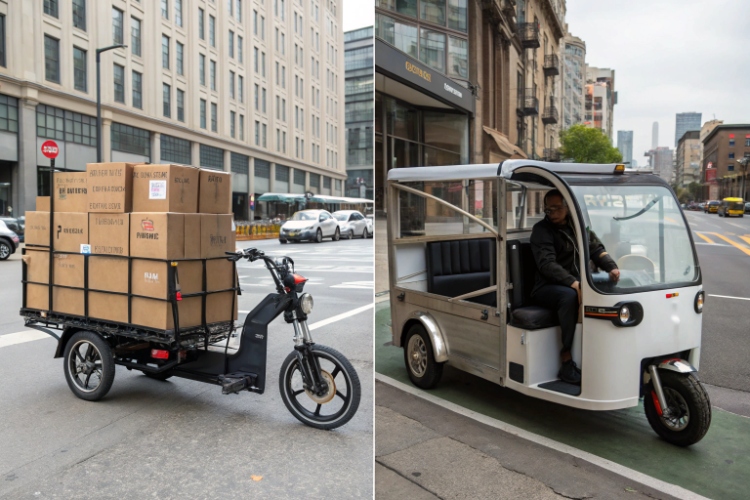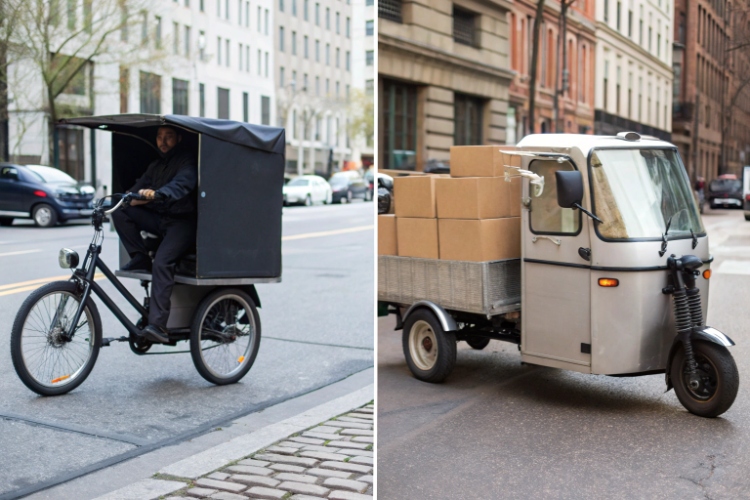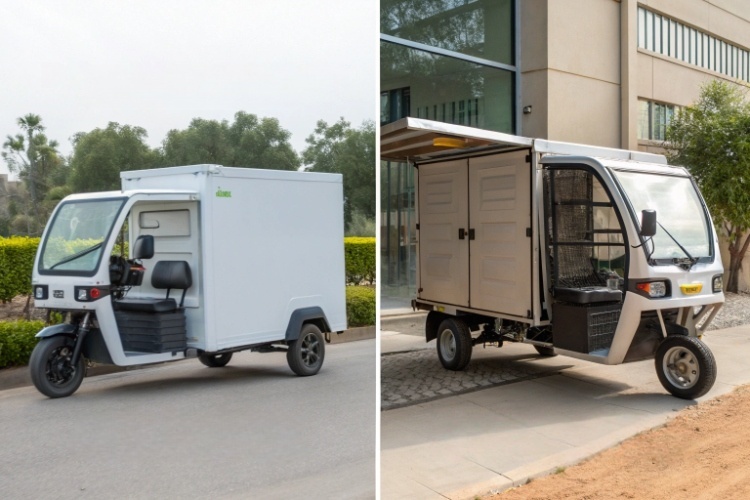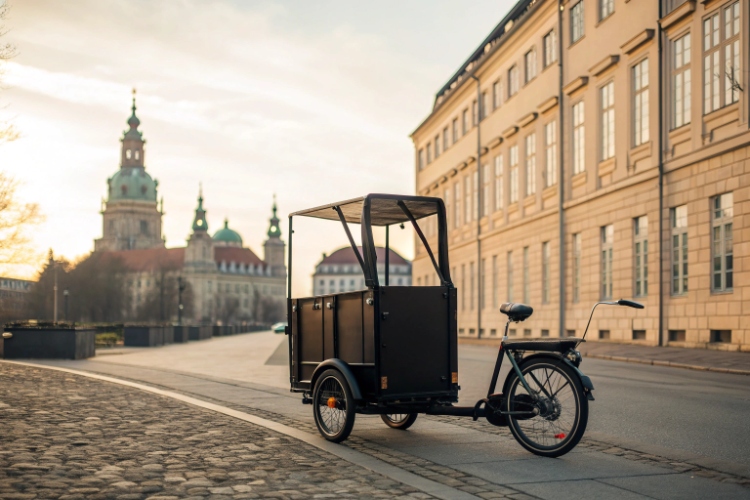Choosing the wrong delivery vehicle means you're either leaving money on the table or failing to meet demand. This inefficiency directly cuts into your profits and limits your business's growth potential.
An electric cargo rickshaw is better for businesses that need to deliver larger volumes or heavier items per trip. A cargo bike is superior for single, small-item deliveries in dense urban areas where speed and agility are the absolute top priorities.

This is a question I discuss with new clients almost every week, especially those starting last-mile delivery businesses. Many are attracted to the idea of a cargo bike because it seems nimble and modern. However, once we analyze their actual business needs—the type of cargo, the number of stops, and the desire to scale—the conversation often shifts. The choice isn't about which vehicle is "best" overall, but which one is the right tool for your specific job. Let's break down the key differences to help you decide.
How do load capacity and stability differ between an electric cargo rickshaw and a cargo bike?
You're worried about your delivery vehicle being able to handle your products. Overloading a small vehicle is inefficient, while a tipped-over load means damaged goods, angry customers, and potential safety hazards.
An electric cargo rickshaw offers superior stability and a much higher load capacity, typically 300-500 kg. A cargo bike is far less stable, requires constant rider balance, and is limited to a much smaller payload of around 50-100 kg.

From a manufacturing standpoint, these two vehicles are built for completely different purposes. A cargo rickshaw is designed on a robust, automotive-style chassis with a solid rear axle. Its three-wheel design creates a wide, stable base that doesn't need to be balanced. You can load it with heavy, unevenly shaped items without worrying about it tipping over when parked or during a sharp turn. In contrast, an electric cargo bike is fundamentally a bicycle. It's built with lighter materials and its stability depends entirely on the skill of the rider. I've seen many businesses try to use cargo bikes, only to find they can't handle the volume or weight of real commercial goods like grocery orders or water jugs.
| คุณสมบัติ | Electric Cargo Rickshaw | Electric Cargo Bike |
|---|---|---|
| Typical Payload | 300 - 500 kg | 50 - 100 kg |
| ความมั่นคง | Excellent (self-balancing) | Poor (requires rider balance) |
| Cargo Box Volume | Large (1.5 - 2.5 cubic meters) | Small (often just a front basket) |
| ดีที่สุดสำหรับ | Bulk goods, groceries, multiple parcels | Single documents, a pizza box |
Which option offers better range, battery life, and performance for short-distance deliveries?
Your delivery vehicle running out of power halfway through the day is a business killer. This stops your operations, delays deliveries, and leaves your drivers and customers frustrated.
The electric cargo rickshaw offers significantly better range and battery options. Its larger frame has a dedicated battery compartment that can house bigger, more powerful battery packs, making all-day commercial operation possible without a mid-day recharge.

This is a simple matter of physics and design. As a factory, we can easily equip a cargo rickshaw with a large 60V or 72V battery pack, whether it's affordable lead-acid or high-performance lithium. There is physically more space. This allows the rickshaw to not only travel a longer distance but also to power a stronger motor capable of moving heavy loads. An electric cargo bike, on the other hand, is limited by weight and space. It uses a much smaller, lighter battery pack that is often integrated into the frame. While a cargo bike might feel faster when empty due to its lower weight, it can't sustain that performance under a real commercial load for a full workday. The rickshaw's larger battery capacity is essential for businesses that need to make many deliveries on a single trip.
How do operating costs, maintenance needs, and durability compare for daily commercial use?
You're worried that a cheap upfront purchase will lead to high repair bills later. A vehicle that is constantly in the shop for maintenance isn't making you any money and is a drain on resources.
An electric cargo rickshaw is built with more durable, automotive-grade components designed for heavy daily use, resulting in lower long-term operating costs. A cargo bike uses standard bicycle parts that wear out quickly under commercial stress, leading to more frequent maintenance.

This is where my experience as a manufacturer really comes into play. We build our cargo rickshaws with components designed to last under commercial abuse. They feature strong rear axles, automotive-style drum brakes, and thick steel frames. These parts are made to handle 500 kg loads, day in and day out. A cargo bike uses bicycle components: a chain, sprockets, and lightweight disc brakes. These parts are designed for a person's weight, not for hundreds of kilograms of commercial cargo. For a delivery business, this means a cargo bike will need constant adjustments, brake pad replacements, and new chains. The rickshaw, while requiring basic checks, is fundamentally a more robust and durable machine, which translates to a lower total cost of ownership over its lifespan.
| Aspect | Electric Cargo Rickshaw | Electric Cargo Bike |
|---|---|---|
| ความทน | High (Automotive-grade parts) | Low (Bicycle-grade parts) |
| การซ่อมบำรุง | Less frequent, more robust | Frequent adjustments and replacements |
| Upfront Cost | สูงกว่า | ต่ำกว่า |
| Long-Term Cost | ต่ำกว่า | Higher (due to repairs/replacement) |
How can distributors or small businesses decide which vehicle type fits their delivery routes and cargo volume?
You're stuck trying to decide which vehicle is the right investment. Making the wrong choice could mean buying a vehicle that can't do the job or overspending on one you don't need.
Analyze your primary delivery task. If your business relies on delivering multiple packages or heavy goods per trip, choose the rickshaw. If your business is built on speed for single, lightweight items in a dense city, the bike is your tool.

To make it simple, I always ask my clients to answer these questions about their business. The right choice becomes very clear once you define the job you need the vehicle to do.
| Decision Factor | Choose an Electric Cargo Bike If... | Choose an Electric Cargo Rickshaw If... |
|---|---|---|
| ประเภทสินค้า | You deliver small, light items like documents, single food orders, or pharmacy items. | You deliver groceries, laundry, water bottles, construction supplies, or bulk packages. |
| Volume per Trip | Your goal is one delivery at a time, as fast as possible. | Your goal is to deliver to 5, 10, or 20+ customers on a single route. |
| Route Terrain | You operate in a dense city with narrow streets and dedicated bike lanes. | You operate in varied urban or suburban areas with normal roads, potholes, and some hills. |
| Business Model | Your value is speed for a single customer. | Your value is efficiency and the ability to serve many customers per hour. |
Ultimately, a cargo bike is a tool for a specific task. A cargo rickshaw is a versatile business asset you can build an entire delivery operation around.
บทสรุป
The right choice is clear: for scalable, high-volume, or heavy-goods delivery, the electric cargo rickshaw is the superior business investment due to its capacity, durability, and lower long-term cost.

